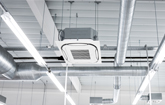Carbon Monoxide Exposure a Threat in California Homes During Heating Season; Accounts for 700 Injuries and Hospitalizations Each Year
Honeywell Encourages Residents To Install Carbon Monoxide Detectors To Stay Safe
MINNEAPOLIS, Nov. 27, 2012 /PRNewswire/ -- As the heating season begins, owners of multi-family homes in California have an added reason to make sure carbon monoxide (CO) detectors are installed in their properties: the Carbon Monoxide Poisoning Prevention Act, which requires multi-family homes to install carbon monoxide detectors within the home by January 1, 2013.
A recent study found that in California only one in ten homes have CO detectors and nationally, only 34 percent of homes have carbon monoxide detectors installed. According to the Centers for Disease Control, 20,000 people visit the emergency room and 500 die every year due to carbon monoxide poisoning. In California, officials estimate that CO poisoning accounts for nearly 700 avoidable injuries and hospitalizations each year.
As the heating season approaches, the risk of exposure to carbon monoxide is heightened because of increased use of furnaces, space heaters, unvented space and kerosene heaters, gas water heaters and wood stoves and fireplaces. When appliances that burn fuel are not in good working condition or properly vented, or used incorrectly, they release a colorless, odorless gas that in high levels can kill in minutes and is undetectable without an alarm.
The requirement for CO detector installation for single-family homes went into effect July, 2011.
Carbon Monoxide Awareness Tips From Honeywell
As California residents are preparing for winter, Honeywell offers five simple tips to keep your family safe:
- Install CO detectors in your home. Honeywell recommends purchasing CO detectors directly from your HVAC contractor because of their expertise in knowing exactly where the detector should be placed in the home. Additionally, most contractors can offer to replace detector batteries during annual HVAC service calls and will offer service agreements. When your contractor is in your home for your annual furnace check, ask them to install a carbon monoxide detector that meets UL safety standards with an audible alarm in every bedroom -- such as Honeywell's C8600 detector, which is approved for use in garages, RVs and other living spaces. The California State Fire Marshall recommends one CO detector on each floor and one outside each sleeping area.
- Keep CO detectors free of dust and debris and make certain the batteries are in good working order.
- Regularly check the vents on your fireplace and stove for improper connections, visible cracks, rust or stains. Make sure that they are open and expel the gas outside the house. Make sure that the flues and chimneys in your house are inspected on a yearly basis.
- Take your CO detector's alarm seriously. Don't ignore the beeping even if you believe the detector is malfunctioning. Get all residents out of the house and call 9-1-1 immediately.
- Know the symptoms of CO poisoning. At moderate levels, you or your family can get severe headaches, become dizzy, mentally confused, nauseated, or faint. It could prove fatal if these levels persist for a long time. Low levels of CO poisoning can cause shortness of breath, mild nausea, and mild headaches, and may have longer term effects on your health. Since many of these symptoms are similar to those of the flu, food poisoning, or other illnesses, you may not think that CO poisoning could be the cause.
Honeywell Carbon Monoxide Detectors
While there are many CO detectors on the market, Honeywell's C8600 is a professional grade CO detector, not sold in retail. It is the only technology tested false alarm-free by the Lawrence Berkeley National Laboratory and is designed not to sound an alarm when exposed to common household products such as disinfectants, cleaners, solvents, air fresheners and alcohol. In addition, it comes with a one-year limited warranty. For more information on Honeywell CO detectors visit www.yourhome.honeywell.com.
Honeywell (www.honeywell.com) is a Fortune 100 diversified technology and manufacturing leader, serving customers worldwide with aerospace products and services; control technologies for buildings, homes and industry; turbochargers; and performance materials. Based in Morris Township, N.J., Honeywell's shares are traded on the New York, London, and Chicago Stock Exchanges. For more news and information on Honeywell, please visit www.honeywellnow.com.
This release contains certain statements that may be deemed "forward-looking statements" within the meaning of Section 21E of the Securities Exchange Act of 1934. All statements, other than statements of historical fact, that address activities, events or developments that we or our management intends, expects, projects, believes or anticipates will or may occur in the future are forward-looking statements. Such statements are based upon certain assumptions and assessments made by our management in light of their experience and their perception of historical trends, current economic and industry conditions, expected future developments and other factors they believe to be appropriate. The forward-looking statements included in this release are also subject to a number of material risks and uncertainties, including but not limited to economic, competitive, governmental, and technological factors affecting our operations, markets, products, services and prices. Such forward-looking statements are not guarantees of future performance, and actual results, developments and business decisions may differ from those envisaged by such forward-looking statements.
Contact:
Tammy Benker Swanson
Honeywell
+1-763-954-4917
[email protected]
SOURCE Honeywell
WANT YOUR COMPANY'S NEWS FEATURED ON PRNEWSWIRE.COM?
Newsrooms &
Influencers
Digital Media
Outlets
Journalists
Opted In





Share this article